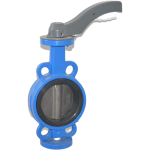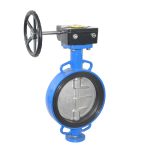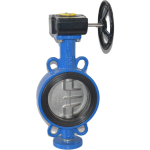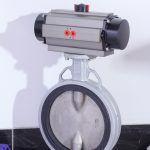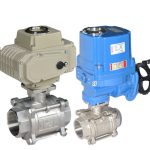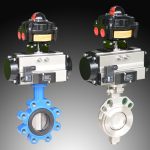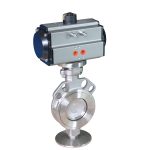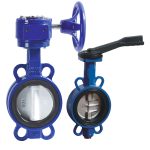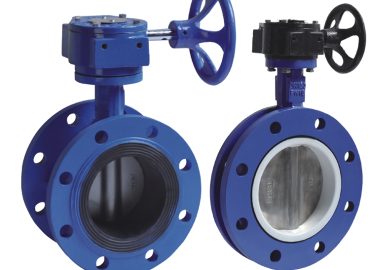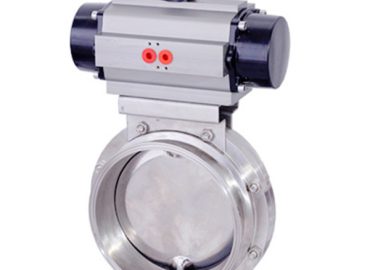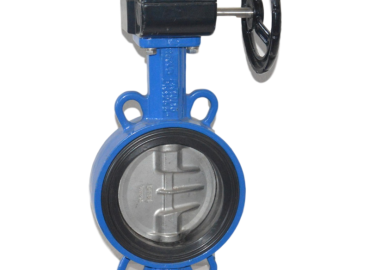Butterfly valves play a crucial role in fluid flow control systems, offering efficient and reliable performance across a wide range of industries and applications. When it comes to selecting and installing butterfly valves, understanding the specific requirements of each valve type is essential to ensure optimal system performance, safety, and longevity. One common size used in various systems is the 10-inch butterfly valve, which, like other valves, may have unique installation requirements depending on its design and application. This article aims to explore the differences in installation requirements for 10-inch butterfly valves, shedding light on the various factors that engineers must consider to achieve a successful and efficient installation that contributes to the overall effectiveness of their fluid flow control systems.
Introduction
When it comes to the installation requirements of 10-inch butterfly valves, there are several factors that can differ depending on the valve type, design, and application. For instance, wafer, lug, and flanged butterfly valves each have unique flange compatibility and bolting arrangements, necessitating careful consideration of piping system compatibility, including pipe diameter, material, and flange standards. Additionally, the valve orientation, whether horizontal or vertical, along with the disc orientation and flow direction, can impact the installation process and overall system performance. Ensuring proper support and alignment of the valve within the piping system is crucial, as misalignments or insufficient support can result in operational issues and premature wear on components. Furthermore, selecting and installing the appropriate actuator, be it manual, electric actuator, pneumatic actuator, or hydraulic, requires a thorough understanding of the specific torque and control requirements of the 10-inch butterfly valve, taking into account factors such as operating pressure, temperature, and fluid compatibility. Finally, addressing common challenges, such as space constraints, accessibility, and sealing considerations, is essential for a successful installation that ensures smooth operation and long-term reliability. By carefully evaluating these various factors and adhering to best practices, engineers can effectively navigate the installation requirements of 10-inch butterfly valves, optimizing fluid flow control systems across diverse industries and applications.
Brief overview of butterfly valves
Butterfly valves are a widely-used type of flow control device, designed to regulate or isolate the flow of fluids in various industries and applications. They consist of a circular disc mounted on a rotating shaft, which, when turned, opens or closes the valve by moving the disc into or out of the flow path. Butterfly valves are known for their compact design, lightweight nature, and cost-effectiveness, making them an attractive choice for systems with limited space and budgets. They can be operated using manual, electric, pneumatic, or hydraulic actuators, providing versatile control options tailored to specific requirements. Available in various designs, such as wafer, lug, and flanged types, as well as double offset and triple offset configurations, butterfly valves cater to a broad range of pressure, temperature, and fluid compatibility needs. With their efficient performance and adaptability, butterfly valves have become a staple in many industries, including water treatment, oil and gas, chemical processing, and HVAC systems, ensuring reliable and precise fluid flow management.

Importance of proper valve selection and installation
The importance of proper valve selection and installation cannot be emphasized enough, as these factors play a crucial role in the overall performance, safety, and reliability of fluid flow control systems. Choosing the right valve type, size, material, and configuration ensures that the system operates at its peak efficiency while minimizing energy consumption, wear on components, and potential operational issues such as turbulence, cavitation, and leakage. Proper installation, on the other hand, guarantees that the selected valve functions optimally within the system, providing a tight seal, smooth operation, and long service life. Inadequate installation can result in misalignments, leaks, or even catastrophic failures, leading to costly repairs, downtime, and potential environmental hazards. By carefully considering the specific requirements of each application and adhering to best practices during the installation process, engineers can optimize their fluid flow control systems, contributing to the success, competitiveness, and sustainability of their operations across various industries.
Focus on 10-inch butterfly valves and their installation requirements
Focusing specifically on 10-inch butterfly valves, their installation requirements warrant careful consideration to ensure optimal system performance and longevity. These valves cater to a diverse range of applications, spanning across industries such as water treatment, oil and gas, and chemical processing. As such, their installation requirements can vary depending on factors like valve type, design, and the specific demands of the application. From flange compatibility and bolting arrangements to valve orientation and actuator selection, each aspect plays a crucial role in achieving a successful and efficient installation. By thoroughly understanding the unique installation requirements of 10-inch butterfly valves and adhering to best practices, engineers can effectively integrate these valves into their fluid flow control systems, ensuring reliable and precise flow management tailored to their specific needs and operational conditions.
Types of 10-inch Butterfly Valves
When it comes to 10-inch butterfly valves, there are several types and designs available to accommodate the diverse needs of various industries and applications. Wafer type butterfly valves, for instance, are a popular choice due to their compact design, lightweight nature, and cost-effectiveness. They are installed between two flanges using bolts that span across the entire length of the valve, making them suitable for systems with limited space and budgets. Lug type butterfly valves, on the other hand, feature threaded bolt holes that enable them to be installed between two flanges using separate sets of bolts, allowing for easy removal of one side of the piping system without disrupting the other. This makes lug type valves ideal for applications that require maintenance or frequent disassembly. Flanged butterfly valves, as the name suggests, come with flanges that are either integrally cast or attached to the valve body, providing a secure connection to the piping system and ensuring proper sealing. Double offset and triple offset butterfly valves, also known as high-performance and triple eccentric valves, respectively, offer enhanced sealing capabilities and reduced wear on components by minimizing contact between the disc and seat during operation. These valves are particularly well-suited for high-pressure, high-temperature, or corrosive applications where tight shut-off and reliability are paramount. By understanding the unique characteristics and benefits of each type of 10-inch butterfly valve, engineers can make informed decisions when selecting the most appropriate valve for their specific fluid flow control requirements, ensuring optimal system performance and longevity.
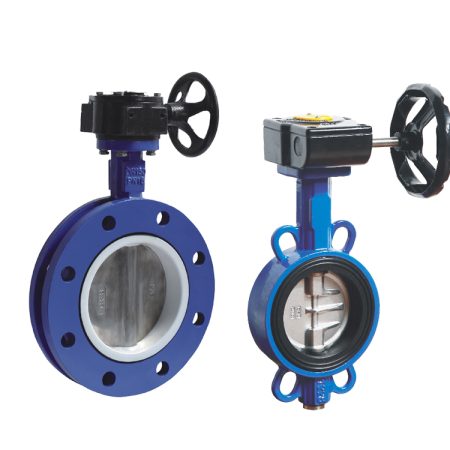
Wafer type butterfly valves
Wafer type butterfly valves are a widely-used and versatile flow control solution, known for their compact design, lightweight nature, and cost-effectiveness. These valves consist of a disc attached to a rotating shaft, which opens or closes the valve by moving the disc into or out of the flow path. Wafer type butterfly valves are installed between two flanges using bolts that span the entire length of the valve, making them ideal for systems with limited space and budget constraints. They offer quick and easy operation, often utilizing manual, electric, pneumatic, or hydraulic actuators depending on the specific requirements of the application. While wafer type butterfly valves may not provide the same level of sealing performance as some other valve types, they are suitable for a wide range of applications, including water treatment, HVAC systems, and general-purpose fluid flow control, where moderate pressure and temperature conditions are present. By selecting and installing the appropriate wafer type butterfly valve, engineers can effectively manage fluid flow in various systems, ensuring reliable performance and operational efficiency.
Lug type butterfly valves
Lug type butterfly valves are a robust and versatile flow control solution, offering several advantages over their wafer counterparts. These valves consist of a disc connected to a rotating shaft, which opens or closes the valve by positioning the disc within the flow path. The key distinguishing feature of lug type butterfly valves is their threaded bolt holes, allowing them to be installed between two flanges using separate sets of bolts. This design provides the ability to remove one side of the piping system for maintenance or replacement without disrupting the other, making lug type valves ideal for applications that require frequent disassembly or easy access for servicing. While typically heavier and more expensive than wafer type butterfly valves, lug type valves offer superior sealing capabilities and can handle higher pressure and temperature conditions. They can be operated using manual, electric, pneumatic, or hydraulic actuators, depending on the specific needs of the application. Lug type butterfly valves are widely used in industries such as water treatment, chemical processing, and oil and gas, where reliable flow control and long-term durability are essential. By selecting and installing the appropriate lug type butterfly valve, engineers can optimize fluid flow management in various systems, ensuring operational efficiency and longevity.
Flanged butterfly valves
Flanged butterfly valves are a reliable and efficient flow control solution, offering several benefits in terms of sealing performance and ease of installation. These valves consist of a disc connected to a rotating shaft, which opens or closes the valve by positioning the disc within the flow path. The defining characteristic of flanged butterfly valves is their flanges, which can either be integrally cast or attached to the valve body, providing a secure connection to the piping system and ensuring proper sealing. Flanged butterfly valves are installed by bolting them directly to the mating flanges of the adjacent pipes, simplifying the installation process and reducing the risk of misalignment. While generally heavier and more expensive than wafer or lug type butterfly valves, flanged valves offer enhanced sealing capabilities and can handle a wide range of pressure and temperature conditions. They can be operated using manual, electric, pneumatic, or hydraulic actuators, depending on the specific needs of the application. Flanged butterfly valves are commonly used in industries such as water treatment, oil and gas, and chemical processing, where reliable flow control and long-term durability are essential. By selecting and installing the appropriate flanged butterfly valve, engineers can optimize fluid flow management in various systems, ensuring operational efficiency and longevity.
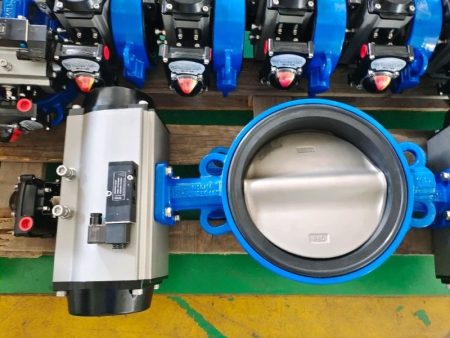
Double offset and triple offset butterfly valves
Double offset and triple offset butterfly valves, also known as high-performance and triple eccentric valves respectively, are advanced flow control solutions designed to provide superior sealing capabilities and reduced wear on components. These valves consist of a disc connected to a rotating shaft, which opens or closes the valve by positioning the disc within the flow path. The distinguishing features of double and triple offset butterfly valves are their unique disc and seat designs, which minimize contact between these components during operation. In double offset valves, the shaft is positioned slightly off-center from both the disc and the seat, while triple offset valves incorporate an additional angular offset for the seat. These offsets result in a cam-like action as the disc rotates, reducing friction and wear, and ensuring tight shut-off even under high-pressure, high-temperature, or corrosive conditions. Double and triple offset butterfly valves can be operated using manual, electric, pneumatic, or hydraulic actuators, depending on the specific needs of the application. They are commonly used in industries such as oil and gas, power generation, and chemical processing, where reliability, performance, and long-term durability are essential. By selecting and installing the appropriate double or triple offset butterfly valve, engineers can optimize fluid flow management in demanding applications, ensuring operational efficiency and longevity.
Installation Considerations for 10-inch Butterfly Valves
When installing 10-inch butterfly valves, several crucial factors must be considered to ensure optimal system performance, longevity, and safety. Firstly, it is essential to select the appropriate valve type, material, and design based on the specific application requirements, including pressure and temperature conditions, fluid characteristics, and compatibility with existing piping systems. Once the correct valve has been chosen, proper installation techniques must be employed, starting with a thorough inspection of the valve and its components for any signs of damage or defects. It is also important to verify that the mating flanges are compatible with the selected butterfly valve, ensuring a secure and leak-free connection.
During installation, attention must be paid to the valve’s orientation in the piping system, as some designs may have specific flow direction requirements or necessitate a particular disc position during installation to avoid damage. Moreover, adequate support must be provided for both the valve and the adjacent piping to prevent undue stress and potential failure. When installing the valve between flanges, it is crucial to use the appropriate gaskets, bolting arrangements, and torque specifications to maintain the integrity of the valve and the overall piping system.
Another key consideration during installation is the selection and integration of the appropriate actuator, whether manual, electric, pneumatic, or hydraulic, based on the operational needs and control requirements of the application. Proper alignment and calibration of the actuator are vital to ensure precise valve positioning and reliable performance. Finally, once the valve and actuator have been installed, it is essential to perform thorough testing and commissioning procedures, including hydrostatic pressure tests and functional checks, to confirm the correct operation and sealing performance of the 10-inch butterfly valve. By diligently addressing these installation considerations, engineers can ensure the successful integration of 10-inch butterfly valves into their fluid flow control systems, ultimately resulting in efficient and reliable operation under various conditions.
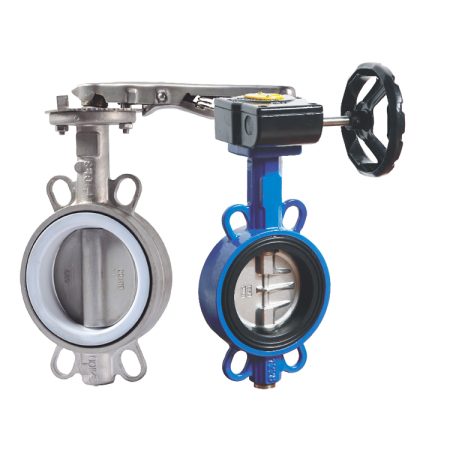
Piping system compatibility
Piping system compatibility is a critical factor to consider when selecting and installing flow control components such as butterfly valves. Ensuring compatibility involves evaluating various aspects of the valve and piping system, including materials, pressure and temperature ratings, flange standards, and gasket requirements. The valve material must be compatible with the pipe material and the fluid being transported to prevent corrosion, erosion, or chemical reactions that could compromise the system’s integrity. Pressure and temperature ratings of the valve and piping system should align to ensure they can withstand the operating conditions without failure. Additionally, flange standards must be consistent across all components in the system, as mismatches in flange dimensions or bolt hole patterns can result in improper sealing and potential leaks. Gasket selection is also crucial, as gaskets must be compatible with both the fluid and the materials of the mating surfaces to ensure a tight seal and prevent leakage. By carefully considering piping system compatibility when selecting and installing butterfly valves, engineers can optimize fluid flow management, ensuring the long-term durability and reliability of the entire system.
Valve orientation
Valve orientation plays a significant role in the proper functioning and longevity of flow control components, such as butterfly valves, within a piping system. The correct orientation ensures that the valve operates efficiently, minimizes wear on its components, and maintains optimal sealing performance. When installing a butterfly valve, it is crucial to consider factors such as the flow direction, disc position, and actuator placement. The flow direction may be specified by the valve manufacturer to avoid potential damage to the valve components or to ensure the best sealing and flow characteristics. In some cases, the disc must be placed in a specific position during installation to prevent damage to the sealing surfaces when tightening the flange connections. Actuator placement also plays a vital role in valve orientation, as it must be easily accessible for operation, maintenance, and monitoring while not obstructing other components in the system. Furthermore, the actuator should be positioned to minimize stress on the valve stem and other internal components during operation. By carefully considering valve orientation during installation, engineers can ensure the efficient and reliable operation of butterfly valves in various fluid flow control applications, ultimately contributing to the overall performance and durability of the entire system.
Support and alignment
Support and alignment are essential aspects of the installation process for flow control components like butterfly valves, as they directly impact the performance, reliability, and longevity of the entire piping system. Proper support involves providing adequate structural reinforcement for both the valve and the adjacent pipes to prevent stress, sagging, or misalignment that could lead to leaks, component wear, or even system failure. This can be achieved by using appropriate pipe hangers, supports, or brackets designed for the specific material, weight, and size of the pipes and valves in the system.
Alignment is equally critical to ensure that the valve components, such as the disc and the seat, are positioned correctly within the flow path, enabling optimal sealing and flow characteristics. Misaligned valves can result in increased friction, wear, or damage to internal components, ultimately reducing the valve’s lifespan and affecting the system’s overall performance. To achieve proper alignment, it is crucial to follow the manufacturer’s guidelines regarding the positioning of the valve within the piping system and the tightening sequence of flange connections, as well as to use appropriate gaskets and bolting arrangements.By paying close attention to support and alignment during the installation of butterfly valves, engineers can optimize fluid flow management, minimize the risk of leaks or component failures, and ensure the long-term durability and reliability of the entire piping system.

Actuator selection and installation
Actuator selection and installation are critical aspects of implementing flow control components like butterfly valves, as the actuator is responsible for the precise positioning and operation of the valve within the piping system. Choosing the appropriate actuator involves evaluating factors such as the required level of control, the speed of response, the available power sources, and the environmental conditions. Common types of actuators include manual, electric, pneumatic, and hydraulic, each with its unique advantages and considerations depending on the specific application.
Once the suitable actuator has been selected, proper installation and integration with the valve are crucial to ensure reliable performance and longevity. This involves ensuring correct alignment between the actuator and the valve stem, as well as proper mounting and secure connections. In some cases, additional components such as gearboxes, positioners, or limit switches may be required to enhance the actuator’s functionality and control capabilities.
It is also essential to calibrate the actuator to ensure accurate valve positioning and responsiveness, following the manufacturer’s guidelines for adjustment and setting procedures. Finally, the actuator should be installed in a location that allows easy access for operation, maintenance, and monitoring while not obstructing other components in the system.By carefully considering actuator selection and installation, engineers can optimize the performance and reliability of butterfly valves in various fluid flow control applications, ultimately contributing to the overall efficiency and durability of the entire system.
Common Challenges and Solutions in Installing 10-inch Butterfly Valves
Installing 10-inch butterfly valves can present several challenges that, if not addressed properly, may impact the performance, reliability, and longevity of the entire piping system. One common challenge is ensuring compatibility between the valve, the mating flanges, and the fluid being transported. To overcome this, it is crucial to select valve materials and designs that are compatible with the fluid properties and the existing piping system, as well as verifying that the flange standards and gasket requirements align with those of the adjacent components.Another challenge arises from the proper alignment and support of the valve and the surrounding pipes. This can be addressed by using appropriate pipe hangers, supports, or brackets designed for the specific material, weight, and size of the pipes and valves in the system, as well as following the manufacturer’s guidelines regarding the positioning of the valve within the piping system and the tightening sequence of flange connections.Actuator selection and installation also present challenges, as the actuator must be compatible with the valve, provide the required level of control, and suit the available power sources and environmental conditions. To resolve this, engineers should carefully evaluate factors such as control requirements, speed of response, power source availability, and environmental factors when selecting an actuator, and ensure proper alignment, mounting, and calibration during installation.
Ensuring the correct valve orientation is another challenge, as improper orientation can lead to reduced performance, increased wear, or even damage to the valve components. This can be addressed by following the manufacturer’s recommendations for flow direction, disc position, and actuator placement, ensuring that the valve operates efficiently and maintains optimal sealing performance.Lastly, thorough testing and commissioning procedures must be performed after installation to verify the correct operation and sealing performance of the 10-inch butterfly valve. This includes hydrostatic pressure tests and functional checks, which help confirm that the valve is operating as intended and identify any potential issues before they escalate.By anticipating and addressing these common challenges in installing 10-inch butterfly valves, engineers can optimize fluid flow management, ensuring the long-term durability and reliability of the entire system.
Space constraints and accessibility
Space constraints and accessibility are important factors to consider when installing butterfly valves, as they can significantly impact the ease of operation, maintenance, and monitoring of the valve and the surrounding piping system. In tight or congested spaces, selecting a compact valve design with a smaller footprint may be necessary to ensure proper fit and integration within the existing layout. Additionally, the actuator’s size, type, and mounting orientation should be considered to minimize obstruction and facilitate smooth operation. When dealing with space constraints, it is crucial to plan for adequate clearance around the valve and actuator to allow for easy access during maintenance tasks, such as inspections, adjustments, or component replacements. This may involve strategically positioning the valve and actuator within the system, as well as incorporating removable panels or access points in the surrounding infrastructure. By carefully considering space constraints and accessibility during the installation of butterfly valves, engineers can optimize the overall efficiency and maintainability of the fluid flow control system, ensuring reliable performance and longevity.

Handling and lifting considerations
Handling and lifting considerations are essential factors to take into account when installing butterfly valves, as improper practices can lead to damage to the valve components, injuries to personnel, or even accidents that compromise the integrity of the entire piping system. When dealing with large or heavy valves, it is crucial to use appropriate lifting equipment, such as hoists, slings, or forklifts, that are rated for the weight and dimensions of the valve. Additionally, lifting points on the valve should be clearly identified and utilized according to the manufacturer’s guidelines to ensure a secure and balanced load during handling.
Personnel involved in the installation process must be trained in proper lifting techniques and safety procedures to minimize the risk of injury or accidents. This includes wearing appropriate personal protective equipment (PPE), such as gloves, safety shoes, and hard hats, as well as following established communication protocols during lifting operations. It is also essential to carefully plan and coordinate the installation sequence, allowing for adequate space and time to maneuver the valve and associated components into position without causing damage or disruption to other elements of the piping system.By paying close attention to handling and lifting considerations during the installation of butterfly valves, engineers can minimize the risk of damage, injury, or accidents, ensuring a smooth and efficient process that contributes to the long-term durability and reliability of the fluid flow control system.
Ensuring a tight seal and smooth operation
Ensuring a tight seal and smooth operation of butterfly valves is crucial for the efficiency, reliability, and durability of the entire fluid flow control system. Achieving a tight seal involves proper valve selection, alignment, and installation practices. To begin with, it is essential to select a valve design and material that are compatible with the fluid properties and pressure requirements of the application. This may involve choosing between different types of seals, such as resilient-seated or metal-seated designs, based on their sealing performance and resistance to wear.Proper alignment during installation is vital for maintaining optimal sealing performance, as misaligned valves can lead to increased friction, wear, or damage to internal components. This can be achieved by following the manufacturer’s guidelines regarding the positioning of the valve within the piping system and the tightening sequence of flange connections, as well as using appropriate gaskets and bolting arrangements.
Smooth operation of butterfly valves is contingent upon the correct orientation, actuator selection, and installation. Ensuring the right valve orientation, disc position, and actuator placement contributes to efficient operation and minimizes wear on valve components. Careful actuator selection and installation, including proper alignment, mounting, and calibration, ensure precise valve positioning and responsiveness.Lastly, regular maintenance and inspections are critical for maintaining a tight seal and smooth operation over time. This includes checking for signs of wear or damage to the sealing surfaces, lubricating moving parts as needed, and recalibrating actuators if necessary. By prioritizing these aspects, engineers can optimize the performance and longevity of butterfly valves in various fluid flow control applications, ultimately contributing to the overall efficiency and durability of the entire system.
Troubleshooting common installation issues
Troubleshooting common installation issues is a vital aspect of ensuring the optimal performance and longevity of butterfly valves in fluid flow control systems. One common issue is misalignment between the valve and the adjacent piping, which can lead to leaks or increased wear on internal components. To resolve this, engineers should verify the correct positioning of the valve, ensure proper tightening of flange connections, and use appropriate gaskets and bolting arrangements as per the manufacturer’s guidelines.Another common challenge is selecting and installing the appropriate actuator for the valve. Engineers should carefully evaluate factors such as control requirements, speed of response, power source availability, and environmental conditions when selecting an actuator. Proper alignment, mounting, and calibration during installation are crucial to ensure accurate valve positioning and responsiveness.
In cases where space constraints and accessibility present challenges, it is important to select compact valve designs and actuators that suit the available space while still providing easy access for operation, maintenance, and monitoring. This may involve strategic positioning of the valve and actuator within the system or incorporating removable panels or access points in the surrounding infrastructure.Lastly, regular maintenance and inspections are essential for identifying and addressing potential issues before they escalate. This includes checking for signs of wear or damage to the sealing surfaces, lubricating moving parts as needed, and recalibrating actuators if necessary. By proactively troubleshooting common installation issues, engineers can optimize the performance and reliability of butterfly valves, ensuring the long-term durability and efficiency of the entire fluid flow control system.
Tips for Successful 10-inch Butterfly Valve Installation
When it comes to ensuring a successful 10-inch butterfly valve installation, there are several key factors that engineers and installers should consider. First and foremost, selecting the appropriate valve design and material is crucial, as it must be compatible with the fluid properties, pressure requirements, and temperature range of the application. This may involve choosing between different types of seals, such as resilient-seated or metal-seated designs, based on their sealing performance and resistance to wear.Another important aspect is proper alignment and support of the valve and surrounding pipes, which can be achieved by using appropriate pipe hangers, supports, or brackets designed for the specific material, weight, and size of the pipes and valves in the system. Additionally, following the manufacturer’s guidelines regarding the positioning of the valve within the piping system and the tightening sequence of flange connections is essential to maintain optimal sealing performance and minimize wear on internal components.
Space constraints and accessibility should also be considered when planning the installation process. This may involve selecting compact valve designs and actuators that suit the available space while still providing easy access for operation, maintenance, and monitoring. Strategic positioning of the valve and actuator within the system, as well as incorporating removable panels or access points in the surrounding infrastructure, can help address these challenges.Handling and lifting considerations are crucial during the installation process to prevent damage to the valve components, injuries to personnel, or accidents that compromise the integrity of the entire system. Using appropriate lifting equipment, such as hoists, slings, or forklifts, rated for the weight and dimensions of the valve, and following proper lifting techniques and safety procedures can ensure a smooth and efficient installation process.

Actuator selection and installation are critical aspects of a successful butterfly valve installation. Engineers should carefully evaluate factors such as control requirements, speed of response, power source availability, and environmental factors when selecting an actuator. Proper alignment, mounting, and calibration during installation are essential for achieving accurate valve positioning and responsiveness.Finally, thorough testing and commissioning procedures must be performed after installation to verify the correct operation and sealing performance of the 10-inch butterfly valve. This includes hydrostatic pressure tests and functional checks, which help confirm that the valve is operating as intended and identify any potential issues before they escalate. By following these tips for successful 10-inch butterfly valve installation, engineers can optimize fluid flow management, ensuring the long-term durability and reliability of the entire system.
Consult manufacturer guidelines and industry standards
Consulting manufacturer guidelines and adhering to industry standards are essential when installing butterfly valves, as they provide valuable insights and best practices to ensure the optimal performance, reliability, and longevity of the fluid flow control system. Manufacturer guidelines typically cover aspects such as valve selection, installation procedures, actuator compatibility, and maintenance requirements, as well as offering specific recommendations tailored to the particular valve design and materials. These guidelines help engineers and installers avoid common pitfalls and ensure that the valve operates efficiently and maintains its optimal sealing performance throughout its lifespan. Industry standards, such as those established by the American Society of Mechanical Engineers (ASME) or the International Organization for Standardization (ISO), provide additional guidance on general installation practices, safety precautions, and quality control measures. By consulting manufacturer guidelines and adhering to industry standards, engineers and installers can minimize potential issues, streamline the installation process, and maximize the overall efficiency and durability of the butterfly valve and the entire fluid flow control system.
Collaborate with experienced professionals and suppliers
Collaborating with experienced professionals and suppliers is a crucial aspect of ensuring a successful butterfly valve installation and optimal performance of the fluid flow control system. By engaging with experts who possess extensive knowledge in valve design, selection, and installation, engineers can gain valuable insights and guidance that help avoid common pitfalls and achieve a seamless integration of the valve into the existing piping system. Working closely with reputable suppliers allows for access to high-quality products, materials, and components that are specifically tailored to the unique requirements of the application, ensuring compatibility and durability. Moreover, experienced professionals can offer training and support in areas such as proper handling techniques, safety procedures, and maintenance practices, which contribute to the long-term reliability and efficiency of the valve and the entire system. Establishing strong relationships with trusted industry partners not only enhances the success of the installation process but also fosters continuous improvement and innovation within the fluid flow control sector.
Thoroughly inspect and prepare the components before installation
Thoroughly inspecting and preparing the components before installation is an essential step in ensuring the successful integration and long-term reliability of butterfly valves within a fluid flow control system. Prior to installation, all valve components, including the valve body, disc, seals, and gaskets, should be carefully examined for any signs of damage, defects, or contamination that could compromise the valve’s performance or sealing capabilities. This process helps identify potential issues before they escalate, allowing for corrective measures to be taken promptly.
In addition to inspection, proper preparation of the components is crucial. This may involve cleaning the sealing surfaces and removing any debris, rust, or foreign materials that could interfere with the valve’s operation or cause premature wear. Lubricating moving parts, such as the valve stem and bearings, can help reduce friction and ensure smooth operation during initial start-up and throughout the valve’s lifespan.
Furthermore, it is important to verify that all components are compatible with the specific application requirements, such as fluid properties, pressure ratings, and temperature ranges. This ensures that the valve and its components can withstand the operational conditions and maintain their integrity over time.By thoroughly inspecting and preparing the components before installation, engineers can minimize potential issues, streamline the installation process, and maximize the overall efficiency and durability of the butterfly valve and the entire fluid flow control system.
Regularly monitor and maintain the valves after installation
Regularly monitoring and maintaining butterfly valves after installation is essential for ensuring their optimal performance, reliability, and longevity within the fluid flow control system. By establishing a comprehensive maintenance schedule based on the manufacturer’s guidelines and industry best practices, engineers can proactively detect and address potential issues before they escalate, preventing costly downtime or system failures.
Routine inspections should focus on key components such as the sealing surfaces, valve disc, stem, and bearings, checking for signs of wear, damage, or corrosion that could compromise the valve’s sealing capabilities or smooth operation. Additionally, monitoring the actuator’s performance, including proper alignment, mounting, and calibration, helps maintain precise valve positioning and responsiveness.
Regular maintenance tasks may involve cleaning the valve components, lubricating moving parts as needed, and replacing worn or damaged seals, gaskets, or other components to ensure a tight seal and efficient operation. In cases where the valve is exposed to harsh environments or aggressive fluids, more frequent inspections and maintenance may be necessary to prevent premature wear or damage.By regularly monitoring and maintaining butterfly valves after installation, engineers can optimize the performance and extend the lifespan of these critical components, ultimately contributing to the overall efficiency and durability of the entire fluid flow control system.

Conclusion
In conclusion, the successful installation, operation, and maintenance of butterfly valves in fluid flow control systems require a comprehensive approach that encompasses various key aspects. By carefully selecting the appropriate valve design and materials, adhering to manufacturer guidelines and industry standards, and collaborating with experienced professionals and suppliers, engineers can ensure the optimal performance and durability of the valve within the system. Thorough inspection and preparation of components before installation, as well as regular monitoring and maintenance after installation, further contribute to the reliability and longevity of the valve and the entire fluid flow control system.
Establishing strong relationships with trusted industry partners, staying up-to-date with the latest advancements in valve technology, and continuously seeking opportunities for improvement and innovation are crucial for achieving the best possible results in fluid flow management. Ultimately, by incorporating these strategies and best practices, engineers can maximize the efficiency and reliability of butterfly valves, enhancing the overall effectiveness of the fluid flow control system and ensuring its long-term success in various industrial and commercial applications.
Recap of key points
To recap the key points, a successful butterfly valve installation and operation in fluid flow control systems involve careful valve design and material selection, adherence to manufacturer guidelines and industry standards, and collaboration with experienced professionals and suppliers. Thorough inspection and preparation of components before installation, as well as regular monitoring and maintenance after installation, contribute significantly to the valve’s reliability and longevity. By following these best practices and establishing strong partnerships within the industry, engineers can optimize the performance of butterfly valves, enhance the efficiency of fluid flow control systems, and ensure long-term success across various applications.
Importance of proper installation for optimal valve performance
The importance of proper installation for optimal valve performance cannot be overstated, as it plays a crucial role in ensuring the efficiency, reliability, and longevity of butterfly valves within fluid flow control systems. A well-executed installation process that adheres to manufacturer guidelines and industry standards helps prevent common issues such as leaks, malfunctions, or premature wear, which can lead to costly downtime or system failures. Moreover, proper installation ensures that the valve operates smoothly and maintains its sealing capabilities throughout its lifespan, contributing to the overall effectiveness of the fluid flow management. By collaborating with experienced professionals, thoroughly inspecting and preparing components, and regularly monitoring and maintaining the valve after installation, engineers can optimize valve performance and enhance the success of their fluid flow control systems across various industrial and commercial applications.
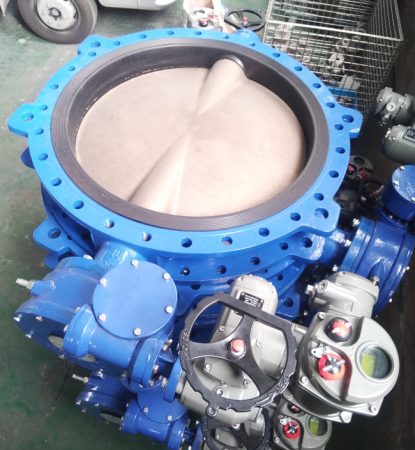
Encouragement to seek professional guidance and adhere to best practices
It is highly encouraged for engineers and technicians involved in butterfly valve installation and maintenance to seek professional guidance and adhere to industry best practices. By collaborating with experienced professionals, valuable insights can be gained that help avoid common pitfalls and ensure seamless integration of the valve into the fluid flow control system. Leveraging the expertise of industry partners not only contributes to the success of the installation process but also fosters continuous improvement and innovation within the sector. Furthermore, following best practices in inspection, component preparation, and regular maintenance ensures optimal valve performance, reliability, and longevity. Ultimately, seeking professional guidance and adhering to best practices are essential steps towards achieving the highest level of efficiency and effectiveness in fluid flow management across various applications.



